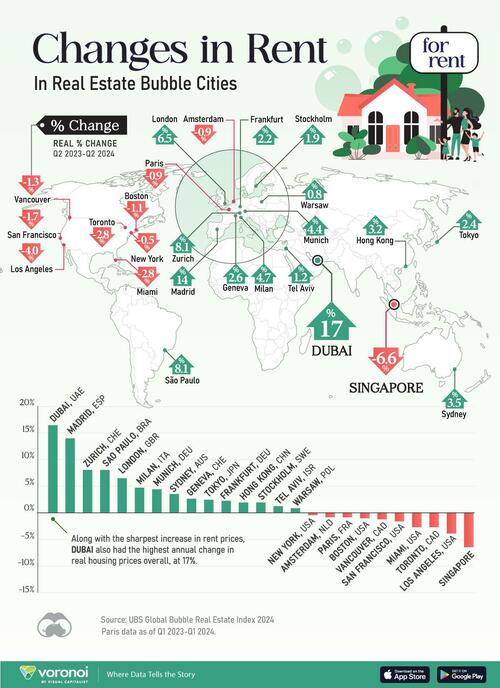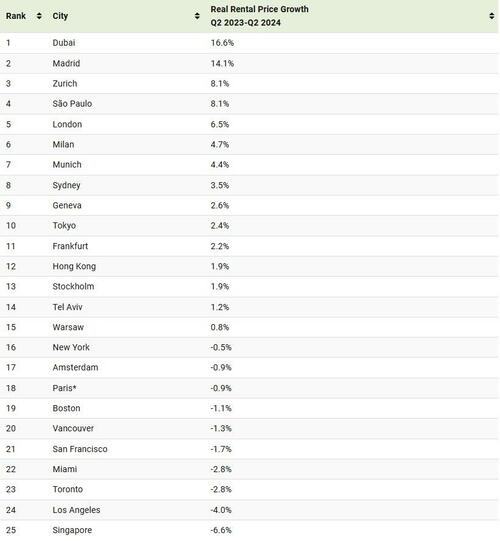
Across real estate bubble cities, average rent prices have increased 5% since mid-2022 in real terms, while inflation-adjusted home prices have dropped 15%.
This has played a role in lowering bubble risk over the last two years. In this way, higher rent prices reflect fundamental demand, such as higher population growth, rather than speculation pushing up home prices. Higher incomes across cities has a similar effect in lowering bubble risk.
This graphic, via Visual Capitalist's Dorothy Neufeld, shows the annual change in real rental costs in bubble markets, based on data from UBS’ Global Real Estate Bubble Index 2024.
Rental Costs Are Soaring in Key Bubble Markets
Although real rents have increased modestly across bubble cities, we can see in the table below that select cities are seeing much higher demand:
*Paris data as of Q1 2023-Q1 2024.
Since 2020, real rents in Dubai have surged 60%, outpacing the 40% rise in real home prices.
This growth reflects a booming population, with 400,000 people moving to the city over the past four years. By 2040, Dubai’s population is expected to grow from 3.8 million to 5.8 million. Today, office occupancy in the financial hub now stands at 91%, surpassing many global centers.
Similarly, Madrid has seen average rent prices climb. Surging rental costs in Madrid have led to thousands of protesters taking the streets as real rents have risen at nearly triple the rate of real home prices in the last year.
In contrast, real rents in Singapore have fallen nearly 7%, following government efforts to curb foreign demand. This shift breaks from the previous five years, when rent prices outpaced the property market as the population expanded and housing construction faced delays.
From a regional standpoint, bubble cities in North America saw the vast majority of declines in average real rent prices. Leading these decreases were Los Angeles (-4.0%), Toronto (-2.8%), and Miami (-2.8%), which rank among the top five bubble risk cities in 2024.
To learn more about this topic from a U.S.-perspective, check out this graphic on the cities with the highest median rent in America in 2024.
Across real estate bubble cities, average rent prices have increased 5% since mid-2022 in real terms, while inflation-adjusted home prices have dropped 15%.
This has played a role in lowering bubble risk over the last two years. In this way, higher rent prices reflect fundamental demand, such as higher population growth, rather than speculation pushing up home prices. Higher incomes across cities has a similar effect in lowering bubble risk.
This graphic, via Visual Capitalist’s Dorothy Neufeld, shows the annual change in real rental costs in bubble markets, based on data from UBS’ Global Real Estate Bubble Index 2024.
Rental Costs Are Soaring in Key Bubble Markets
Although real rents have increased modestly across bubble cities, we can see in the table below that select cities are seeing much higher demand:
*Paris data as of Q1 2023-Q1 2024.
Since 2020, real rents in Dubai have surged 60%, outpacing the 40% rise in real home prices.
This growth reflects a booming population, with 400,000 people moving to the city over the past four years. By 2040, Dubai’s population is expected to grow from 3.8 million to 5.8 million. Today, office occupancy in the financial hub now stands at 91%, surpassing many global centers.
Similarly, Madrid has seen average rent prices climb. Surging rental costs in Madrid have led to thousands of protesters taking the streets as real rents have risen at nearly triple the rate of real home prices in the last year.
In contrast, real rents in Singapore have fallen nearly 7%, following government efforts to curb foreign demand. This shift breaks from the previous five years, when rent prices outpaced the property market as the population expanded and housing construction faced delays.
From a regional standpoint, bubble cities in North America saw the vast majority of declines in average real rent prices. Leading these decreases were Los Angeles (-4.0%), Toronto (-2.8%), and Miami (-2.8%), which rank among the top five bubble risk cities in 2024.
To learn more about this topic from a U.S.-perspective, check out this graphic on the cities with the highest median rent in America in 2024.
Loading…






